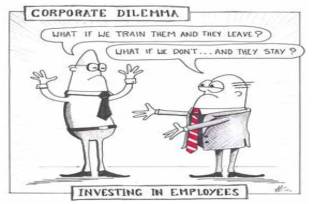I recently came across a cartoon which revealed a conversation between a CFO and a CEO. The CFO asked the CEO what happens if we train them and they leave? The CEO responded what happens if don’t and they stay.
So what happens if you don’t?
Low staff morale, performance inefficiencies, business stagnation, poor knowledge retention and high turnover. Those are the expected results of little or no training and development in your organization. I would like to hazard a guess that you are in business to make a profit and to keep doing so. Training your staff provides them with the skills to innovate (Barber 2004, as cited in Aguinis & Kraiger, 2009) and facilitates organizational knowledge retention (Acton & Golden, 2002). Training then provides some stability for your employees and your business and helps to ensure its longevity. With improved skill comes the opportunity for increased productivity, effectiveness, and operating profit. Research shows that continuous investment in training will result in increased job satisfaction and reduced levels of job-related stress (Acton & Golden, 2002).
So my question to you is, why not make the investment in training?
References
Acton, T., & Golden, W. (2002). Training: The way to retain valuable IT employees. Informing Science, (pp. 1-12).
Aguinis, H., & Kraiger, K. (2009). Benefits of training and development for individuals and teams, organizations, and society. Annual review of psychology, 60, 451-474.
For the audio recording of this post, click the play button below.


Great elevator pitch! This summary was extremely concise and enjoyable to listen to. The cartoon illustration was also used extremely well within your article. You shared that “training then provides some stability for your employees and your business and helps to ensure its longevity. Research shows that continuous investment in training will result in increased job satisfaction and reduced levels of job-related stress (Acton & Golden, 2002).” I would agree that job satisfaction and reduced stress are related and training and building into employees will help reduce this trend. After listening to your article why do you think employers are so reluctant to invest more into their employees?
Acton, T., & Golden, W. (2002). Training: The way to retain valuable IT employees. Informing Science, (pp. 1-12).
LikeLike
Camille
That was short and sweet. I can certainly relate to the dilemma that you have described – we train people to use Blackboard, screencast, flip the classroom, and in two years they leave, and we’re back to square one. However, the consequences of not training have been aptly described by you. What people fail to realize is that the reason for the high turnover may be a lack of training itself (Hoffman, 2000)!
Reference:
Hoffman, R. (2000, May 15). Increasing Opportunities for Learning Can Lower Turnover. Retrieved October 30, 2016, from http://www.inc.com/articles/2000/05/19087.html
LikeLike
BTW, this is Neville
LikeLike
Great elevator pitch! It was concise and to the point. The scenario you described is one that I often see within my school district. While the district trains small groups, and at times the whole, there is still turnover. Once they train the district once, there isn’t necessarily comprehensive training for new employees. This leads to employee frustrations and additional turnovers.
LikeLike